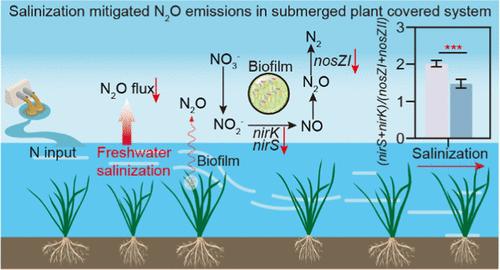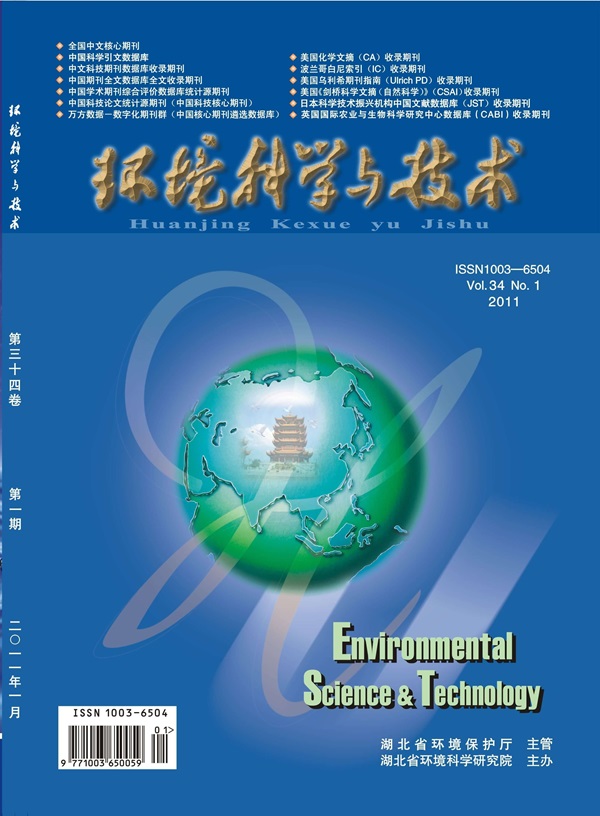Freshwater Salinization Mitigated N2O Emissions in Submerged Plant-Covered Systems: Insights from Attached Biofilms
IF 11.3
1区 环境科学与生态学
Q1 ENGINEERING, ENVIRONMENTAL
引用次数: 0
Abstract
Submerged plants (SMPs) play a critical role in improving water quality and reducing N2O greenhouse gas emissions. However, freshwater salinization represents a major environmental challenge in aquatic systems. To investigate the impact of salinization on N2O emissions, this study conducted indoor mesocosm experiments simulating SMP and nonsubmerged plant (Non_SMP) areas in freshwater lakes. The objective was to explore the effects and microbial mechanisms of the attached biofilm on N2O emission in freshwater salinization. Salinization systems (700–1500 μS cm–1) reduced N2O flux by 37.0 and 40.5% compared to freshwater systems (<700 μS cm–1) of SMPs and Non_SMPs, respectively. Kinetic experiments showed that the reduction in N2O emissions was mainly attributed to the attached biofilm rather than the sediment or water. The N2O net emission rates of the attached biofilm decreased by 47.1 and 71.8% in salinization systems of SMPs and Non_SMPs, respectively, compared with freshwater systems. Additionally, biofilms in salinization systems exhibited lower denitrification rates. Furthermore, salinization reduced the N2O production potential ((nirS + nirK)/(nosZI + nosZII)), thereby further decreasing N2O emissions. This study provides valuable insights into the role and mechanisms of biofilms in mitigating N2O emissions in salinized freshwater lakes.

淡水盐碱化减少了淹没植物覆盖系统中N2O的排放:来自附着生物膜的见解
沉水植物在改善水质和减少N2O温室气体排放方面发挥着重要作用。然而,淡水盐碱化是水生系统的一个主要环境挑战。为了研究盐渍化对N2O排放的影响,本研究在淡水湖中进行了模拟SMP区和非淹没植物区(Non_SMP)的室内中生态实验。目的是探讨附着生物膜对淡水盐碱化过程中N2O排放的影响及其微生物机制。盐碱化体系(700 ~ 1500 μS cm-1)比淡水体系(700 μS cm-1)分别减少了37.0%和40.5%的N2O通量。动力学实验表明,N2O排放的减少主要归功于附着的生物膜,而不是沉积物或水。smp和non_smp盐渍化系统的附着生物膜N2O净排放率分别比淡水系统降低了47.1和71.8%。此外,生物膜在盐碱化系统中表现出较低的反硝化速率。此外,盐碱化降低了N2O生产潜力((nirS + nirK)/(nosZI + nosZII)),从而进一步减少了N2O排放。本研究为生物膜在盐碱化淡水湖中减少N2O排放的作用和机制提供了有价值的见解。
本文章由计算机程序翻译,如有差异,请以英文原文为准。
求助全文
约1分钟内获得全文
求助全文
来源期刊

环境科学与技术
环境科学-工程:环境
CiteScore
17.50
自引率
9.60%
发文量
12359
审稿时长
2.8 months
期刊介绍:
Environmental Science & Technology (ES&T) is a co-sponsored academic and technical magazine by the Hubei Provincial Environmental Protection Bureau and the Hubei Provincial Academy of Environmental Sciences.
Environmental Science & Technology (ES&T) holds the status of Chinese core journals, scientific papers source journals of China, Chinese Science Citation Database source journals, and Chinese Academic Journal Comprehensive Evaluation Database source journals. This publication focuses on the academic field of environmental protection, featuring articles related to environmental protection and technical advancements.
 求助内容:
求助内容: 应助结果提醒方式:
应助结果提醒方式:


